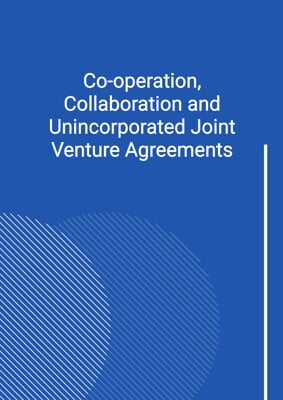
Heads of Agreement (HOA) / Heads of Terms (HOT) - Joint Venture
JV Leader
This Heads of Agreement (HOA) / Heads of Terms (HOT) is applicable in a joint venture situation. This represents the good faith intentions of the parties to proceed but is not legally binding. This document is drafted in favour of the leader of the joint venture.
How to Tailor the Document for Your Need?
01
Create Document
Fill in the details of the parties. You can click the "Fill with Member’s Information" button to complete it with information saved to your account.
02
Fill Information
Please fill in any additional information by following the step-by-step guide on the left hand side of the preview document and click the "Next" button.
03
Get Document
When you are done, click the "Get Document" button and you can download the document in Word or PDF format.
04
Review Document
Please get all parties to review the document carefully and make any final modifications to ensure that the details are correct before signing the document.
Document Preview
Document Description
The document titled 'Heads of Agreement (HOA) / Heads of Terms (HOT) - Joint Venture' is a crucial document that outlines the principles and key details of a proposed joint venture between two parties. It is important as it serves as a preliminary agreement that sets the foundation for the joint venture and provides a framework for further negotiations and the establishment of a joint venture company.
The entire document is divided into several sections, each addressing different aspects of the joint venture. The first section introduces the parties involved in the agreement and their principal places of business. It emphasizes the parties' shared interests in the field and their intention to establish a joint venture that will be mutually beneficial.
The second section focuses on the establishment of the joint venture company. It outlines the parties' intention to create a new jointly-owned company and provides details regarding the name of the joint venture and its headquarters. If applicable, it also specifies the territory in which the joint venture will operate.
The third section delves into the activities of the joint venture. It describes the specific business purpose of the joint venture in the field and highlights the possibility of including other technologies and products as agreed upon by the parties. It also mentions the development of an initial business plan that will be reviewed and updated by the joint venture company's board.
The fourth section addresses the contribution of each party to the joint venture. It states that the parties will transfer their existing interests to the joint venture and outlines the need for both parties to continue their respective businesses in the ordinary course until the joint venture is completed. If applicable, it also covers the technology-related arrangements between the parties.
The fifth section focuses on the valuation of the joint venture. It highlights the parties' intention to agree on a valuation process and methodology, potentially involving the appointment of an independent valuer. It also mentions the provision of information by each party to facilitate the valuation process and the resolution of any differences in valuations.
The sixth section addresses the capital and funding of the joint venture. It states that the parties will hold equity capital on a proportion basis and emphasizes the joint venture's self-financing nature. It also mentions the parties' intention to support the joint venture's business according to the current business plan.
The seventh section discusses the board and management of the joint venture. It outlines the responsibility of the board for overall management and supervision, the appointment of directors by each party, and the equal voting rights of the parties. It also mentions the initial appointments to the board and the senior management positions.
The eighth section focuses on the shareholders' agreement. It highlights that certain key decisions affecting the joint venture will require mutual agreement between the parties. It also mentions other provisions related to dividend policy, auditors, financial year, management accounts, pre-emption rights, non-competition, deadlock, and dispute resolution.
The ninth section addresses third-party approvals that may be required for the joint venture. It emphasizes the parties' commitment to obtaining necessary consents or approvals and their cooperation in the process.
The tenth section covers confidentiality and announcements. It outlines the parties' obligations to keep information confidential and obtain prior written approval for any public announcements or press releases.
The eleventh section discusses dispute resolution and includes a jurisdiction clause. It also provides details regarding notices and service, specifying the methods and timelines for giving notice.
The twelfth section clarifies that the document does not create legal obligations, except for specific clauses related to confidentiality, dispute resolution, notices, and the absence of rights for third parties.
The document concludes with the signatures of the authorized representatives of the parties and references to annexes that provide additional information such as a description of the business, the territory (if applicable), and an outline timetable (if applicable).
How to use this document?
To effectively use the 'Heads of Agreement (HOA) / Heads of Terms (HOT) - Joint Venture' document, follow these steps:
1. Familiarize yourself with the document: Read the entire document carefully to understand its purpose and the key details it covers.
2. Identify the parties and their principal places of business: Ensure that the correct names and addresses of the parties are entered in the agreement.
3. Determine the joint venture company's name and headquarters: Discuss and agree on the name of the joint venture company and its headquarters.
4. Define the business purpose of the joint venture: Clearly describe the specific field in which the joint venture will operate and consider including other technologies and products as agreed upon.
5. Develop an initial business plan: Collaborate with the other party to create an initial business plan that outlines the objectives, strategies, and financial projections of the joint venture. Review and update the plan regularly.
6. Transfer existing interests to the joint venture: If applicable, discuss and agree on the transfer of existing interests to the joint venture. Ensure that both parties continue their respective businesses in the ordinary course until the joint venture is completed.
7. Address technology-related arrangements: If relevant, discuss and establish arrangements for sharing technology, including licensing, improvements, controls, and trademarks.
8. Agree on the valuation process: Negotiate and agree on a valuation process and methodology. Consider appointing an independent valuer if necessary. Provide all requested information to facilitate the valuation process.
9. Determine the capital and funding structure: Discuss and agree on the proportionate equity capital held by each party. Emphasize the joint venture's self-financing nature and the parties' commitment to support the business according to the current business plan.
10. Establish the board and management: Appoint an equal number of directors from each party to the joint venture company's board. Define the roles and responsibilities of key management positions.
11. Draft a shareholders' agreement: Identify key decisions that require mutual agreement and include provisions on dividend policy, auditors, financial year, management accounts, pre-emption rights, non-competition, deadlock, and dispute resolution.
12. Obtain necessary third-party approvals: Identify and obtain any required consents or approvals from other partners, regulatory authorities, and tax authorities.
13. Maintain confidentiality and seek approval for announcements: Keep all information obtained during the negotiation and implementation of the joint venture confidential. Obtain written approval before making any public announcements or press releases.
14. Establish a dispute resolution mechanism: Consider including a jurisdiction clause and follow the agreed-upon process for resolving any disputes that may arise.
15. Serve notices in writing: Ensure that all notices related to the agreement are in writing and served according to the specified methods and timelines.
Note: This guidance provides a general overview of the steps involved in using the document. It is important to consult legal professionals and adapt the guidance to the specific circumstances of the joint venture agreement.
Not the right document?
Don’t worry, we have thousands of documents for you to choose from:
























